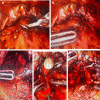A matched-analysis on short-term and long-term (up to 5 years of follow-up) urinary incontinence outcomes after robot-assisted radical prostatectomy with and without anterior and posterior reconstruction: data on 1358 patients
- PMID: 37648873
- PMCID: PMC10776693
- DOI: 10.1007/s11255-023-03766-z
A matched-analysis on short-term and long-term (up to 5 years of follow-up) urinary incontinence outcomes after robot-assisted radical prostatectomy with and without anterior and posterior reconstruction: data on 1358 patients
Abstract
Purpose: We report a comparative monocentric study with a short and long-term follow-up with the aim to assess differences about urinary continence outcomes in patients treated with Robot-Assisted Radical Prostatectomy (RARP) with two different techniques: with anterior and posterior reconstruction and without any kind of reconstruction.
Materials and methods: From January 2016 to September 2021, at the Department of Urology of the "F. Miulli" Hospital of Acquaviva delle Fonti, in Italy, 850 eligible patients underwent extraperitoneal RARP with anterior and posterior reconstruction and 508 without reconstructions.
Results: In patients undergoing RARP with reconstructions 1 month after surgery the urinary continence was preserved in 287/850 patients (33.8%), 3 months after surgery in 688/850 (81%), 6 months in 721/850 (84.8%), 12 months in 734/850 (86.3%), 18 months in 671/754 (89%), 24 months in 696/754 (92.3%), 36 months in 596/662 (90%), 48 months in 394/421 (93.6%), 60 months in 207/212 (97.6%). In patients undergoing RARP without reconstruction 1 month after surgery urinary continence was preserved in 99/508 (19.4%), after 3 months in 276/508 (54.3%), 6 months in 305/508 (60%), 12 months in 329/508 (64.7%), 18 months in 300/456 (65.7%), 24 months in 295/456 (64.7%), 36 months in 268/371 (72.3%), 48 months in 181/224 (81%), 60 months in 93/103 (90.3%).
Conclusion: In our case study, the RARP with anterior and posterior reconstruction technique is associated with a statistically significant higher rate (up to 48 months of follow-up) and a faster recovery of urinary continence compared to the technique without reconstructions.
Keywords: Anterior reconstruction; Continence; Posterior reconstruction; Prostate cancer; Robot-assisted radical prostatectomy; Urethral rhabdosphincter.
© 2023. The Author(s).
Conflict of interest statement
None of the contributing authors have any conflict of interest, including specific financial interests and relationships and affiliations relevant to the subject matter or materials discussed in the manuscript.
Figures
Similar articles
-
A Pragmatic Randomized Controlled Trial Examining the Impact of the Retzius-sparing Approach on Early Urinary Continence Recovery After Robot-assisted Radical Prostatectomy.Eur Urol. 2017 Nov;72(5):677-685. doi: 10.1016/j.eururo.2017.04.029. Epub 2017 May 6. Eur Urol. 2017. PMID: 28483330 Clinical Trial.
-
Retzius-sparing Robot-assisted Radical Prostatectomy Leads to Durable Improvement in Urinary Function and Quality of Life Versus Standard Robot-assisted Radical Prostatectomy Without Compromise on Oncologic Efficacy: Single-surgeon Series and Step-by-step Guide.Eur Urol. 2021 Jun;79(6):839-857. doi: 10.1016/j.eururo.2020.05.010. Epub 2020 Jun 11. Eur Urol. 2021. PMID: 32536488
-
Combined bladder neck preservation and posterior musculofascial reconstruction during robotic assisted radical prostatectomy: effects on early and long term urinary continence recovery.BMC Urol. 2017 Dec 15;17(1):119. doi: 10.1186/s12894-017-0308-1. BMC Urol. 2017. PMID: 29246146 Free PMC article.
-
Current techniques to improve outcomes for early return of urinary continence following robot-assisted radical prostatectomy.Fukushima J Med Sci. 2014;60(1):1-13. doi: 10.5387/fms.2013-25. Epub 2014 Jul 15. Fukushima J Med Sci. 2014. PMID: 25030723 Review.
-
Posterior rhabdosphincter reconstruction during robot-assisted radical prostatectomy: critical analysis of techniques and outcomes.Urology. 2010 Sep;76(3):734-41. doi: 10.1016/j.urology.2010.01.073. Epub 2010 Jun 25. Urology. 2010. PMID: 20579697 Review.
Cited by
-
[Surgical techniques to improve continence after robot-assisted laparoscopic radical prostatectomy based on video-anatomy-a review].Urologie. 2025 Jun 16. doi: 10.1007/s00120-025-02627-0. Online ahead of print. Urologie. 2025. PMID: 40522376 Review. German.
-
Urinary continence outcomes after robot-assisted laparoscopic radical prostatectomy: Significance of anterior reconstruction.Int J Urol. 2025 Apr;32(4):355-360. doi: 10.1111/iju.15654. Epub 2024 Dec 23. Int J Urol. 2025. PMID: 39716777 Free PMC article.
References
-
- Cooperberg MR, et al. The University of California, San Francisco cancer of the prostate risk assessment score: a straightforward and reliable preoperative predictor of disease recurrence after radical prostatectomy. J Urol. 2005;173:1938. doi: 10.1097/01.ju.0000158155.33890.e7. - DOI - PMC - PubMed
-
- Joseph AJ, Smith et al (2017) Hinmans atlas of urologic surgery, 4th edn. Elsevier
MeSH terms
LinkOut - more resources
Full Text Sources
Medical


